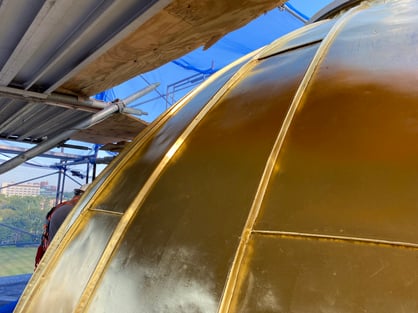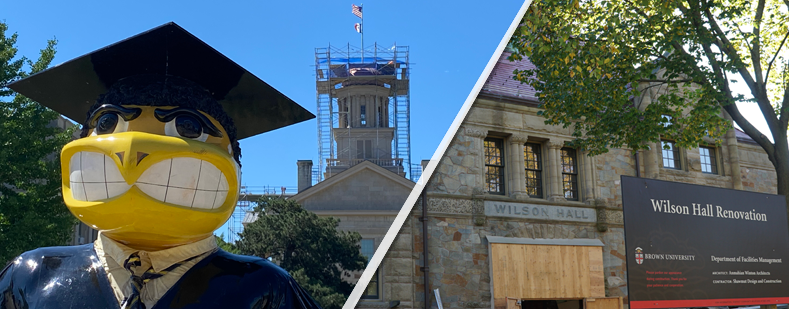In the USA, some college and university campuses were founded 400 years ago, while globally some universities have been operating for nearly a millennia. Often, these institutions' most recognizable features are the unique visual characteristics of the campus' architecture. Whether these renowned structures are well-preserved originals or renovated within the last 100 years, periodic restoration, renovation, or maintenance projects are essential.
When taking on a small or large project at a University, there are many factors to keep in mind, such as proximity to people, proper waste removal and disposal, and worker safety factors. If these matters are not considered, it can pose risks to students, faculty, staff, nearby pedestrians, and the integrity of the building itself.
In the sections below, we've highlighted three types of work frequently undertaken by Universities and their contractor partners:
Restoration Work
Restoration work can be done on a variety of different materials, including metallic surfaces such as cast iron and copper, or stone and other masonry materials, like concrete, and brick. The path for restoration is unique to each situation. Some materials may need to be restored due to environmental staining build-up, failed coatings, corrosion, or a multitude of other variables that degrade the building's visual or structural characteristics. Sponge Media™ is commonly used for restoration projects, as it can both delicately clean the substrate and remove most surface level contaminants while preserving the integrity of the structure.
Universities see thousands of students and visitors each day, so when it comes to restoration work, it’s important that regular operations are able to continue. Both Boston College and the University of Iowa recognized this importance when undergoing restoration projects on their campus.
BC's Carney Hall is on Beacon Street - one of Boston, Massachusetts' busiest streets. Carney Hall's location made safety a top priority when it came time to clean the efflorescence and environmental staining off the granite and limestone façade of the building.
At the University of Iowa, the Old Capitol Museum remained open to the public throughout Old Cap's Dome restoration, meaning visitors and staff were coming in and out daily. This made minimal exposure to airborne particles vital for these projects.
Dome restoration, meaning visitors and staff were coming in and out daily. This made minimal exposure to airborne particles vital for these projects.
Instead of blasting with high rebound media such as slag or garnet, these projects were completed with the use of Sponge Media™. Thanks to its low dust and low rebound capabilities, pedestrians remained safe and operations kept moving as scheduled.
As noted by Cliff Mohling, Sponge-Jet’s Iowa-based Regional Manager, “Micro Containment and low rebound energy minimizes public exposure to dust and particle ricochet. This minimizes disruption in open and public spaces to reduce downtime for the university, and to limit the size of the work area needed to be accommodated”.
Lead Abatement and Other Hazardous Material Removal
When working on projects that involve the abatement of lead or other hazardous materials, proper waste removal and disposal is crucial. When removing hazardous material like lead, PCBs, and hexavalent chromium (found in some pigments, spray paints and coatings) there can be liabilities associated with the improper disposal of hazardous waste. This is known as the "cradle to grave" responsibility. It is not uncommon for contractors who blast with single-use abrasives (garnet, glass, coal slag) to dilute the concentration of hazardous waste with their blast material, fooling hazardous waste tests at disposal sites.
This unethical decision that some make knowingly or unknowingly opens all involved to liability. This liability extends from the contractor performing the abatement work to the university where the waste originated financially responsible for cleanup.
When Wilson Hall at Brown University was being renovated, about 14,000ft2 (1,300m2) of lead paint needed to be removed from brick in the building. By following proper OSHA and EPA requirements for containment and removal of lead, students, faculty, and workers were kept safe during the remediation process.
It is especially important for universities and their assets, that they work with a contractor who will properly dispose of the hazardous waste. “When a properly trained contractor is hired to complete an abatement project, they bring a full range of experience to the project to mitigate the hazardous waste, control the work environment, protect their workers and others nearby, and provide the best quality of work for the project, keeping costs and liability under control,” says Ted Valoria, Vice President - North America, of Sponge-Jet.
By using a recyclable abrasive, such as Sponge Media™, the concentration of the hazard will not be diluted, but the bulk weight of the material will be 85% less than waste generated with garnet or slag, therefore allowing for proper disposal of the waste at a dramatically lower cost, and limiting improper disposal liabilities.
Facility Maintenance
Regular facility maintenance is necessary to ensure that all equipment, machinery, and structures are working as efficiently and safely as possible. In the university setting, this may include HVAC work, routine painting, grounds repairs, and pipe maintenance, amongst many other things. By investing in preventative maintenance work, universities both protect themselves from liabilities and save money in the long run by avoiding high-cost breakdowns and outages.
Commonly found in classrooms, stairwells, basements, and many other locations on campuses is a building material known as CMU block. CMU, also known as concrete masonry blocks, are popular in educational settings due to their durability and resistance to fire, mold, water damage, and pests. While these blocks are cost-effective, they still need to be regularly maintained in order to both increase their longevity and keep up a clean appearance. If failures occur, the concrete can crack creating not only eyesores, but also potential structural issues.
If defacement of property, such as graffiti, occurs on campus, it can be challenging to fully remove. Some kinds of paint can seep through porous masonry surfaces like concrete and brick, sometimes as deep as 2 millimeters. While chemical strippers or power washing are common methods for removal, in this case they typically do not have the ability to completely remove the paint below the surface, leaving staining and discoloration behind. Sponge-Jet cleaning these surfaces allow maintenance professionals to remove all paint, both surface level paint, and the paint that has gotten into the surface's pores.
Outdoor spaces, such as walkways, stairs, and railings can not be forgotten when it comes to regular maintenance. The brightening and removal of old painting and coatings in these areas allows the university to maintain a neat and clean appearance, making a strong first impression towards prospective students and their families. Furthermore, it keeps students, faculty, and visitors safe from any associated hazards while walking throughout campus.








